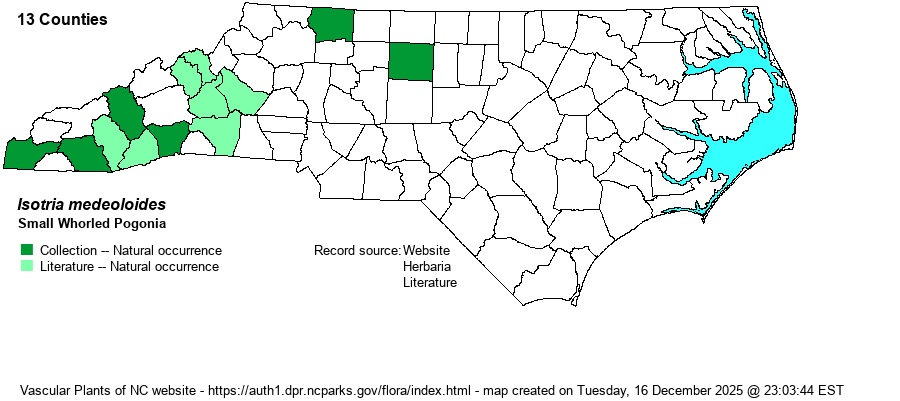| Author | (Pursh) Rafinesque | |
| Distribution | Scattered in the Mountains, though primarily in the southern counties and adjacent southern Piedmont foothills. Extends eastward to Guilford County in the central Piedmont.
This is a Northeastern species, occurring sparingly from ME to southern MI, south to northern GA and southeastern TN. | |
| Abundance | Very rare in the central and southern Mountains and the adjacent Piedmont, east to the South Mountains of Burke and Rutherford counties. Extremely rare farther eastward into the Piedmont. This is a Federal and State Threatened species. In actuality, it ought to be listed at the State level as Endangered, as there is no requirement that the State status match that of the Federal status, and it is one of the rarest plants in NC. Despite its occurrence documented from at least 13 counties, several counties have only historical records, and most sites have only one to a handful of plants. Certainly there are less than 100 individual plants known to be present in the state. | |
| Habitat | Despite its great rarity, the species occurs in ordinary, mostly upland hardwood or mixed forests, on acidic soils -- conditions that are abundant in the mountains and Piedmont. However, most occurrences in NC are near Eastern White Pine (Pinus strobus) where mixed with hardwoods. | |
| Phenology | Blooms in May and June, and fruits within a month after flowering. | |
| Identification | This is a rather short, though erect species, with a single stem growing only to about 6-10 inches high. The green stem is rather fleshy and glaucous to glaucescent. The tip of the stem contains a whorl of normally five entire, elliptical leaves, each about 2-2.5 inches long and about 1 inch wide; they are pale green to glaucescent green and stand out at right angles from the stem. At the junction of the leaves grows a single (rarely two) flower, generally with yellow-green petals and sepals and a white lip; the flower is somewhat less than 1 inch long and wide. Two other species could grow with this species and be confused with it, and both are much more likely to be found by an observer. Isotria verticillata grows slightly taller and is not glaucous to pale green in color; it has a purplish stem and a much larger flower with much longer sepals. Medeola virginiana is a reasonably common species and is often found by the casual observer. It has a more slender and solid stem, which is generally purplish in color, usually has more than five leaves in the whorl, and (when in bloom) has several small flowers atop a second whorl of leaves. Sadly, I. medeoloides often fails to appear aboveground even though it is a perennial plant; also, seldom are more than two or three plants seen at any one site. Thus, its microhabitat requirements seem to be quite specific. | |
| Taxonomic Comments | None
| |
| Other Common Name(s) | Little Five-leaves | |
| State Rank | S1 | |
| Global Rank | G2G3 | |
| State Status | T | |
| US Status | LT | |
| USACE-agcp | FACU link |
| USACE-emp | FACU link |

